
The Piano Sonata No. 11 in A major, K. 331 / 300i, by Wolfgang Amadeus Mozart is a piano sonata in three movements.

Eine kleine Nachtmusik, K. 525, is a 1787 composition for a chamber ensemble by Wolfgang Amadeus Mozart (1756–1791). The German title means "a little night music". The work is written for an ensemble of two violins, viola, cello and double bass, but is often performed by string orchestras. The serenade is one of Mozart's most famous works.

The Symphony No. 39 in E♭ major of Wolfgang Amadeus Mozart, K. 543, was completed on 26 June 1788.
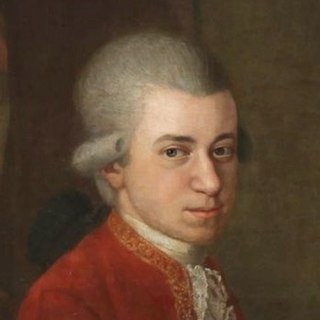
Symphony No. 35 in D major, K. 385, also known as the Haffner Symphony, was composed by Wolfgang Amadeus Mozart in 1782. It was commissioned by the Haffners, a prominent Salzburg family, for the occasion of the ennoblement of Sigmund Haffner the Younger. The Haffner Symphony should not be confused with the eight-movement Haffner Serenade, another piece Mozart wrote on commission from the same family in 1776.

The Symphony No. 29 in A major, K. 201/186a, was completed by Wolfgang Amadeus Mozart on 6 April 1774. It is, along with Symphony No. 25, one of his better known early symphonies. Stanley Sadie characterizes it as "a landmark ... personal in tone, indeed perhaps more individual in its combination of an intimate, chamber music style with a still fiery and impulsive manner."
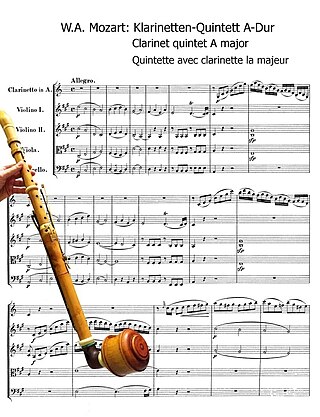
Wolfgang Amadeus Mozart's Clarinet Quintet, K. 581, was written in 1789 for the clarinetist Anton Stadler. A clarinet quintet is a work for one clarinet and a string quartet. Although originally written for basset clarinet, in contemporary performances it is usually played on a clarinet in A. It was Mozart's only completed clarinet quintet, and is one of the earliest and best-known works written especially for the instrument. It remains to this day one of the most admired of the composer's works. The quintet is sometimes referred to as the Stadler Quintet; Mozart so described it in a letter of April 1790. Mozart also wrote a trio for clarinet, viola and piano for Stadler, the so-called Kegelstatt Trio, in 1786.

The Piano Concerto No. 22 in E♭ major, K. 482, is a work for piano, or fortepiano, and orchestra by Wolfgang Amadeus Mozart, composed in December 1785.
The Divertimento in E♭ major, K. 563, is a string trio, written by Wolfgang Amadeus Mozart in 1788, the year in which he completed his last three symphonies and his "Coronation" Piano Concerto. It is his last divertimento and different from his other divertimenti not only in its instrumentation but also in its compositorial ambition and scope.

The Sonata in C major, K. 19d, is a work for piano four-hands once thought to be composed by Wolfgang Amadeus Mozart in 1765 when he was nine years old in England. Composed in the traditional sonata form, it is one of the very few works thought to be written by Mozart for four-handed play.
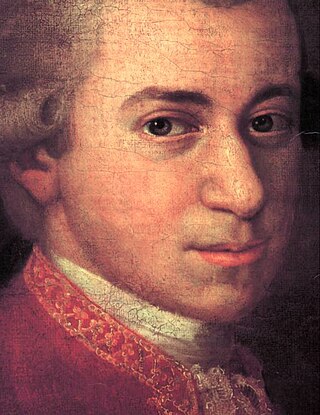
The Serenade No. 10 for winds in B-flat major, K. 361/370a, is a serenade by Wolfgang Amadeus Mozart scored for thirteen instruments: twelve winds and string bass. The piece was probably composed in 1781 or 1782 and is often known by the subtitle Gran Partita, though the title is a misspelling and not in Mozart's hand. It consists of seven movements.
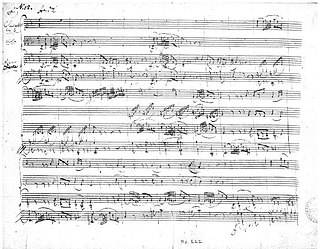
A clarinet–viola–piano trio, often titled "Trio for Clarinet, Viola and Piano" is a work of chamber music that is scored for clarinet, viola, and piano; or is the designation for a musical ensemble of a group of three musicians playing these instruments. This combination of instruments differs from other combinations, as the viola and the clarinet share approximately the same musical range, but not the same tone quality.
The String Quintet No. 2 in C minor, K. 406/516b, was written by Wolfgang Amadeus Mozart in 1787. Like all of Mozart's string quintets, it is a "viola quintet" in that it is scored for string quartet and an extra viola. Unlike his other string quintets, however, the work was not originally written for strings. Having completed the two string quintets K. 515 and K. 516, Mozart created a third by arranging his Serenade No. 12 for Winds in C minor K. 388/384a, written in 1782 or 1783 as a string quintet. Although by then Mozart was entering each new work into his catalogue of compositions, he did not enter this quintet, perhaps because it was an arrangement rather than a new work.

Symphony No. 6 in F major, K. 43, was composed by Wolfgang Amadeus Mozart in 1767. According to Alfred Einstein in his 1937 revision of the Köchel catalogue, the symphony was probably begun in Vienna and completed in Olomouc, a Moravian city to which the Mozart family fled to escape a Viennese smallpox epidemic; see Mozart and smallpox.
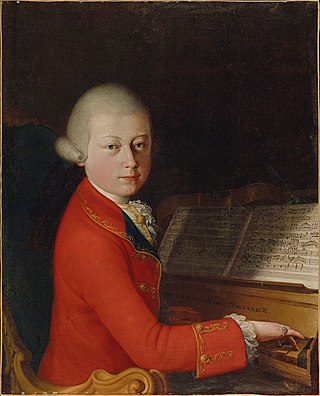
Symphony No. 19 in E-flat major, K. 132, is a symphony composed by Wolfgang Amadeus Mozart in July 1772.
Wolfgang Amadeus Mozart's set of six sonatas for keyboard and violin, K. 26–31 were composed in early 1766 in The Hague during the Mozart family's grand tour of Europe. They were dedicated to Princess Caroline of Nassau-Weilburg on the occasion of the eighteenth birthday of her brother, William V, Prince of Orange. They were published as Mozart's "Opus 4".
The six string quartets, K. 168–173, were composed by Wolfgang Amadeus Mozart in late 1773 in Vienna. These are popularly known as the Viennese Quartets. Mozart may have hoped to have them published at the time, but they were published only posthumously by Johann André in 1801 as Mozart's Op. 94.

The Piano Sonata in B-flat major, K. 498a, is a piano sonata in four movements. It was first printed in 1798 by P. J. Thonus in Leipzig on behalf of Breitkopf & Härtel and attributed to Wolfgang Amadeus Mozart; an edition printed in c. 1805 already credited it as opus 26 of the Thomascantor August Eberhard Müller (1767–1817). Some publications still attribute it to Mozart, often as Piano Sonata No. 20.
The divertimenti in F major, B-flat major, E-flat major, F major, and B-flat major are five companion compositions for pairs of oboes, horns and bassoons by Wolfgang Amadeus Mozart.

The Sonata in C major for piano four-hands, K. 521, is a piano sonata in three movements composed by Wolfgang Amadeus Mozart in 1787. It was his last complete piano duet sonata for one piano, four hands. This sonata consists of three movements: Allegro, Andante and Allegretto.
"Das Traumbild", K. 530, is a song, or Lied, for piano and voice by Wolfgang Amadeus Mozart to a poem by Ludwig Hölty.














